pectus excavatum baby causes
People with the condition may. The brace is worn around the chest and provides pressure from both the front and back to move the breastbone back to its usual position.
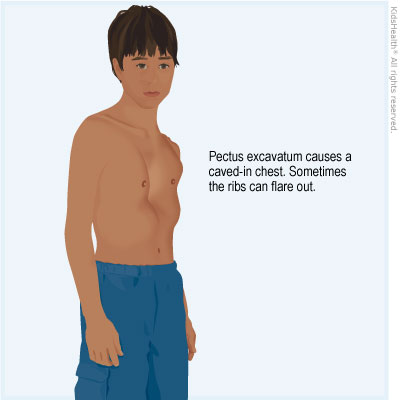
Chest Wall Disorder Pectus Excavatum For Parents Primary Children S Hospital
Pectus excavatum is caused by the abnormal growth in the chest of the connective tissues cartilage that attach the breastbone sternum to the ribs.

. The cartilage pushes the breastbone sternum inward. With pectus excavatum the sternum goes inward to. Pectus excavatum also known as concave chest or funnel chest is a deformity of your childs chest wall.
Usually the ribs and sternum go outward at the front of the chest. Pectus excavatum can range from mild to severe and your child may or may not have symptoms related to the heart or lungs. This information from Great Ormond Street Hospital GOSH is about pectus excavatum also known as funnel chest.
Chest pain related to abnormal bone and cartilage growth. Pectus excavatum is an abnormal development of the rib cage in which the sternum breastbone grows inward resulting in a noticeable and sometimes severe indentation of the chest wall. The breastbone or sternum and some of the ribs grow abnormally causing a depression in the middle of the chest.
Pectus excavatum sometimes called cobblers chest sunken chest or funnel chest is the most common chest deformity affecting between 1 in 300 and 1 in 500 adolescents. It probably originates from a genetic defect that results in abnormal musculoskeletal growth. People who have mild signs and symptoms may be helped by physical therapy.
Read customer reviews find best sellers. This produces a caved-in or sunken appearance of the chestIt can either be present at birth or develop after puberty. The most common chest wall deformity pectus excavatum or sunken chest is most likely caused by abnormal growth of the costal cartilage junction between the ribs and sternum.
The depression in the chest is due to abnormal growth of the cartilage that attaches the sternum to the ribs. Because of the deep depression the lower ribs can stick out and give the appearance of a potbelly in younger children. Ad Browse discover thousands of brands.
As always please refrain from giving medical advice that only a medical professional should provide to our amazing community of Pectus people. Pectus excavatum can impair cardiac and respiratory function and cause pain in the chest and back. Pectus excavatum affects about one in.
Pectus excavatum is a congenital deformity of the chest wall that causes several ribs and the breastbone sternum to grow in an inward direction. Both or just one side of the breastbone may be affected. The condition is not always noticeable at birth but is often apparent by the time a child is 2 to 3.
Talk about your personal experiences ask for advice discuss surgery options meme about built-in cereal bowls etc. Intermittent shortness of breath. It can present in toddlers but typically becomes apparent during the growth spurt and puberty.
The cause of pectus excavatum is unknown. What is pectus excavatum and its symptoms. Pectus excavatum PECK-tuss ex-kuh-VAW-tum is a condition that causes a childs chest to look sunken or caved in It happens because of a defect in the tough connective tissue cartilage that holds the bony part of the ribs to the breastbone.
Decreased endurance with exercise. The condition is also called sunken. The cartilaginous portion of the rib is very likely the main.
Also known as sunken chest or funnel chest pectus excavatum can be corrected with the minimally invasive surgical technique called the Nuss. Pectus excavatum is a structural deformity of the anterior thoracic wall in which the sternum and rib cage are shaped abnormally. What is a pectus excavatum.
A community for discussion of Pectus Excavatum. Bracing for pectus carinatum works similar to the way braces work on teeth. Pectus excavatum is a condition in which instead of being level with the ribs the breastbone sternum is sunken so that the middle of the chest looks caved in.
The child wears the brace for up to 24. It is caused when several ribs and the sternum grow abnormally which produces a caved-in or sunken appearance of the chest. This causes a depression in the chest that can range from mild to severe.
Pectus excavatum is usually congenital present at. Pectus excavatum can be surgically repaired but surgery is usually reserved for people who have moderate to severe signs and symptoms. A depression of the sternal bone.
Amongst doctors dealing with pectus excavatum there is a lot of discussion. A worsening of symptoms as the child grows. Pectus excavatum is a depression caused when the sternum breastbone is abnormally pushed inward.
If pectus carinatum is causing symptoms there are two treatment options. Certain exercises can improve posture and increase the degree to which the chest can expand.

An Extensive Guide To Pectus Excavatum Find Expert Advice
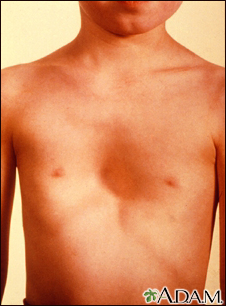
Pectus Excavatum Information Mount Sinai New York

Newborn Care Chest And Abdomen Philadelphia Fight
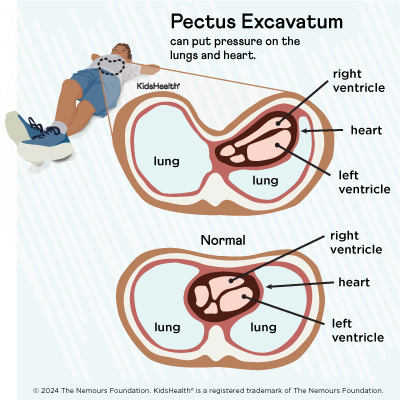
Chest Wall Disorder Pectus Excavatum For Parents Primary Children S Hospital
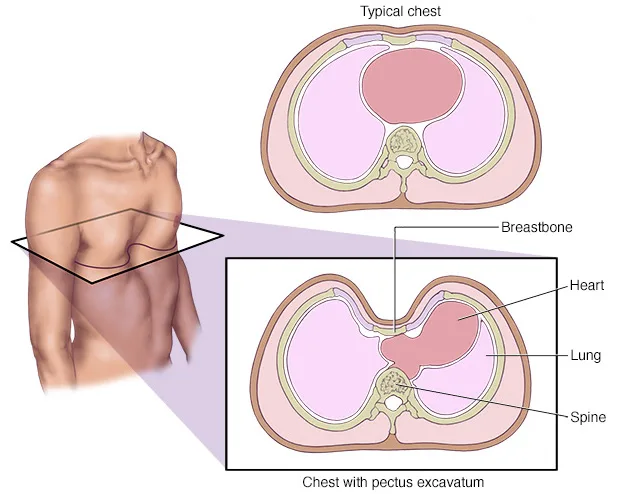
Pectus Excavatum Chest Wall Deformities Child Heart Specialist
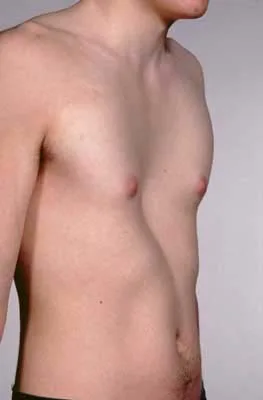
Pectus Excavatum Chest Wall Deformities Child Heart Specialist

Patient 2 Note Cafe Au Lait Spots Pectus Excavatum Widespaced Download Scientific Diagram
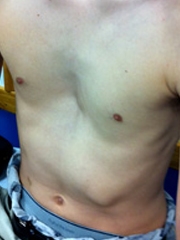
Pectus Excavatum Children S Hospital Of Philadelphia

Pectus Excavatum Overview Symptoms Treatments And More

Nuss Procedure For Pectus Excavatum Background Indications Contraindications

Pectus Excavatum Funnel Chest Asthma Lung Uk

Kidshealth Pectus Excavatum Vacuum Bell Device Akron Children S Hospital

Pectus Excavatum Vancouver Sun

Pectus Excavatum Causes Tests And Treatment Kindle Edition By Hewitt Ma John Awad Md Mohamed Health Fitness Dieting Kindle Ebooks Amazon Com

Chest Wall Disorder Pectus Carinatum Johns Hopkins All Children S Hospital
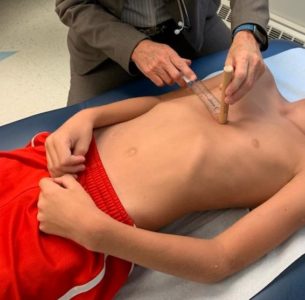
Should I Worry If My Child S Chest Is Sunken Cincinnati Children S Blog

Strength Training With Pectus Excavatum Wasserman Strength

Pectus Excavatum From A Pediatric Surgeon S Perspective Abstract Europe Pmc
